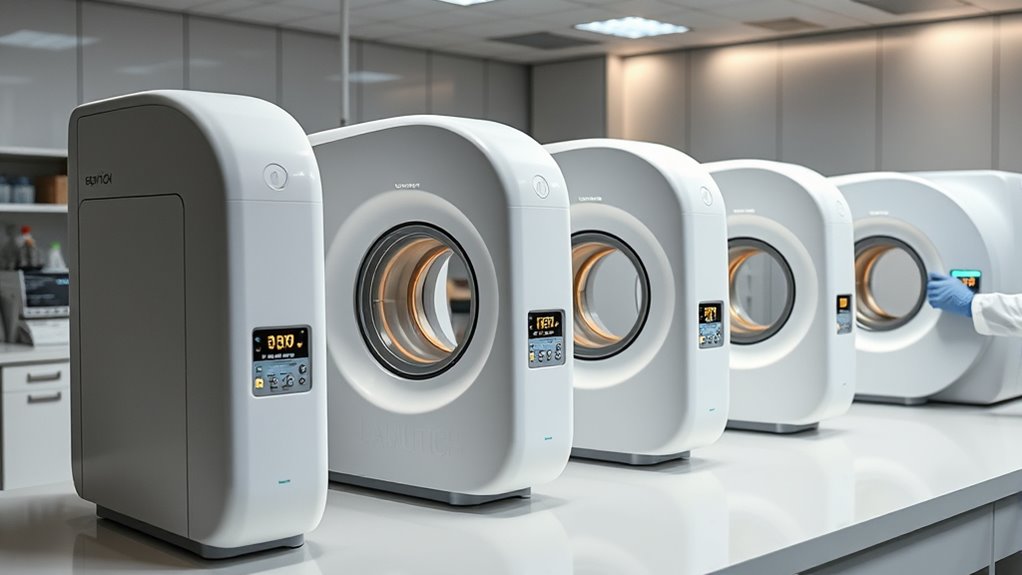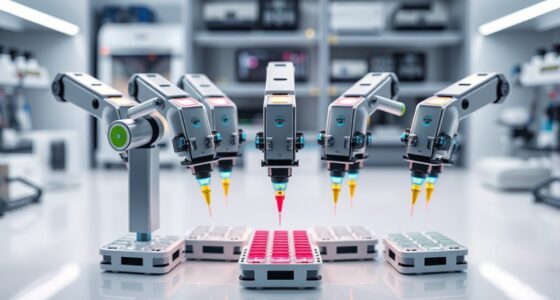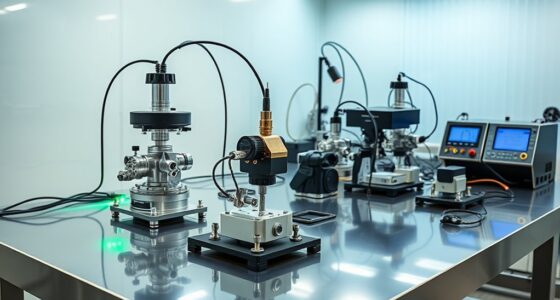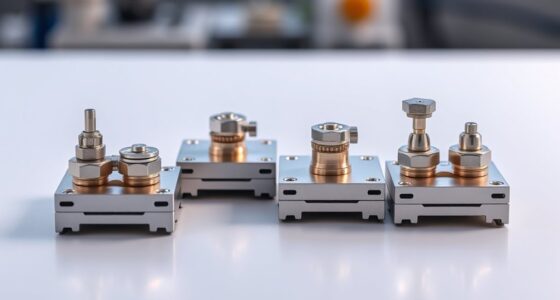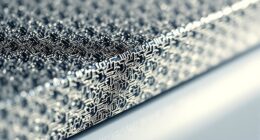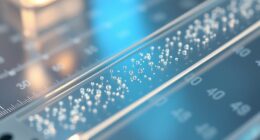When exploring the best nuclear magnetic resonance spectrometers for precise molecular analysis, I focus on high-accuracy, reliable devices like the United Scientific NMRA01 and Truex 800 X-ray spectrometer. These models offer excellent sensitivity, stability, and advanced features suited for detailed research. Whether for industrial, laboratory, or field use, choosing the right tool depends on your specific needs. If you continue exploring, you’ll discover even more effective solutions tailored to your analysis goals.
Key Takeaways
- Nuclear Magnetic Resonance (NMR) spectrometers provide detailed molecular structure and dynamics analysis with high precision.
- Top NMR systems feature high magnetic field strengths, advanced probe technology, and enhanced sensitivity.
- Leading brands include Bruker, JEOL, and Agilent, offering a range of benchtop to high-field spectrometers.
- Considerations include magnetic field strength (e.g., 400 MHz, 600 MHz), sample capacity, and software capabilities.
- Suitable for research, pharmaceutical development, and detailed structural elucidation in molecular chemistry.
Spectryx USBVIS Miniature CCD Spectrometer USB – SMA connectorized
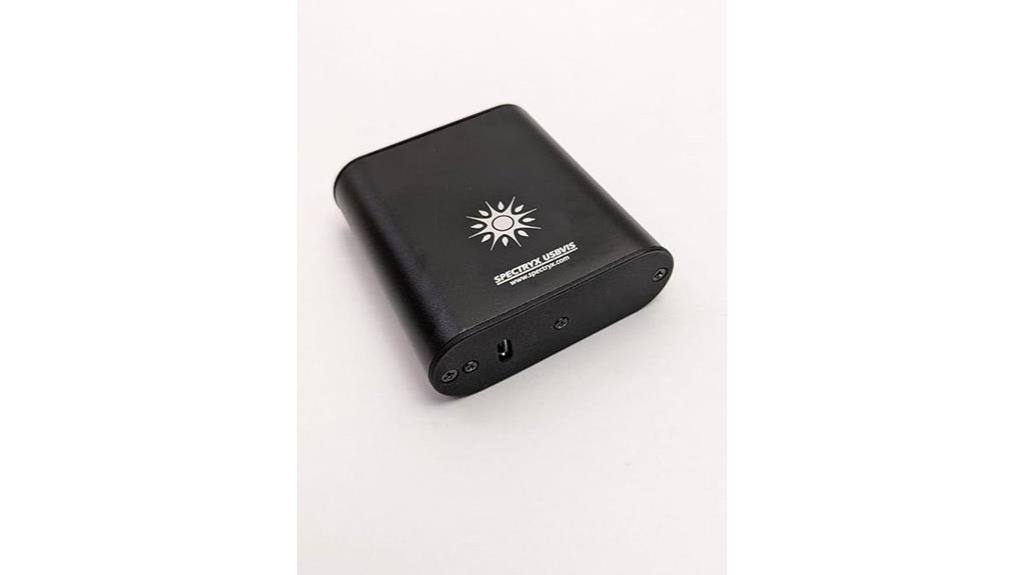
The Spectryx USBVIS Miniature CCD Spectrometer is an excellent choice for researchers and professionals who need a compact, versatile device for spectral analysis. Its USB-SMA connector makes integration straightforward, and its spectral range of 400-850nm covers most visible applications, with some extending to 950nm. The device features a linear CCD detector and a 12-bit ADC, ensuring precise measurements. With an adjustable integrating time from 40ms to 10 seconds, it offers flexibility for various experiments. Compatible with Windows GUI, Python, and Octave, it fits seamlessly into diverse analytical workflows, making it a reliable tool for detailed spectral investigations.
Best For: Researchers and professionals seeking a compact, versatile CCD spectrometer for detailed spectral analysis across the visible range and beyond.
Pros:
- Compact and lightweight design for easy integration and portability
- Wide spectral range (400-850nm, up to 950nm) suitable for diverse applications
- Flexible integrating time (40ms to 10 seconds) allows for precise measurements
Cons:
- No built-in order sorting filter, which may require external filtering for certain applications
- Limited to a 12-bit ADC resolution, which might be less suitable for extremely high-precision measurements
- Compatibility primarily with Windows GUI, Python, and Octave may limit use with other software environments
HPCS-330P Spectrometer PPFD Quantum Meter with Bluetooth

For professionals and hobbyists who need precise, portable light measurements, the HPCS-330P Spectrometer PPFD Quantum Meter with Bluetooth stands out as a top choice. Its wireless Bluetooth connectivity lets you detach the sensor for flexible testing in tight or hard-to-reach spaces. Compact and lightweight, it easily fits into a pocket or bag, making it perfect for on-the-go use. The device measures PPFD, PAR, lux, CCT, and CRI with high accuracy across a wavelength range of 350 to 800 nm. You can save data directly on the device and export detailed reports in Excel, streamlining analysis and documentation for all your light testing needs.
Best For: professionals and hobbyists seeking precise, portable light measurement solutions for grow light testing and general illumination analysis.
Pros:
- Wireless Bluetooth connectivity allows sensor detachment for flexible testing in tight or hard-to-reach spaces
- Compact and lightweight design for easy portability and on-the-go use
- Supports data saving and export to Excel, facilitating detailed analysis and reporting
Cons:
- Wavelength accuracy is ±1 nm, which may be insufficient for extremely precise scientific applications
- Limited to a wavelength range of 350 to 800 nm, excluding UV and IR light measurement
- PC software for report printing is only compatible with Windows systems, limiting options for Mac users
United Scientific NMRA01 Nuclear Magnetic Resonance Apparatus
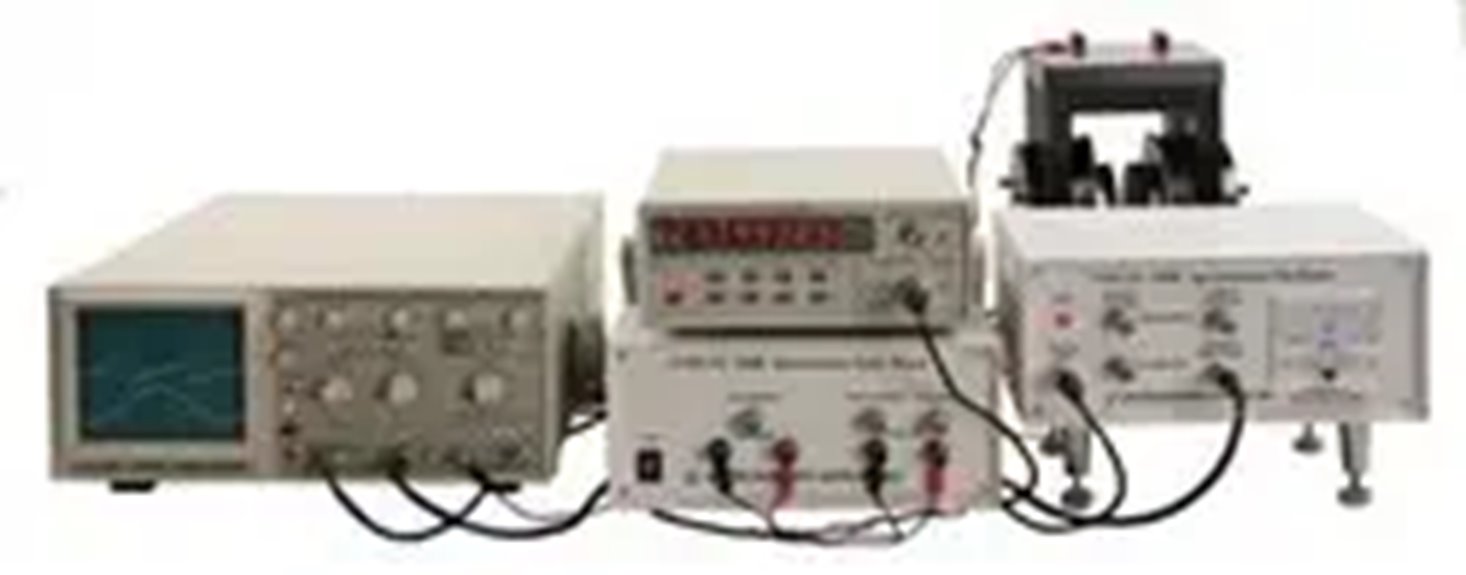
If you’re looking for a reliable NMR apparatus suitable for educational or laboratory research, the United Scientific NMRA01 Nuclear Magnetic Resonance Apparatus stands out. It includes six vial samples, with five aqueous solutions—copper sulfate, ferric chloride, hydrofluoric acid, pure water, manganese sulfate—and an extra glycerin sample. The device features a permanent magnet, oscillator, frequency counter, and power supply, but requires an oscilloscope. It allows me to analyze proton NMR of hydrogen and fluorine, measuring key properties like gyromagnetic ratio, Lande factor, and nuclear magnetic moment. It’s an excellent tool for studying NMR phenomena and nuclear properties across various samples.
Best For: educational institutions and research laboratories seeking a reliable NMR tool for studying nuclear magnetic resonance phenomena and properties in various samples.
Pros:
- Includes a comprehensive set of sample vials for versatile testing.
- Capable of measuring key nuclear properties such as gyromagnetic ratio, Lande factor, and nuclear magnetic moment.
- Features essential components like a permanent magnet, oscillator, and frequency counter for accurate analysis.
Cons:
- Requires an oscilloscope, which may entail additional equipment costs.
- Limited to analyzing specific nuclei (hydrogen and fluorine), restricting broader applications.
- May be less suitable for high-precision or advanced research needs compared to more sophisticated NMR systems.
FNIRSI GC-03 Geiger Counter Electromagnetic Detector

Anyone needing a versatile device that combines radiation detection, electromagnetic field measurement, and environmental monitoring will find the FNIRSI GC-03 Geiger Counter Electromagnetic Detector an excellent choice. It detects Gamma, Beta, and X-ray radiation across a wide dose range, with energy detection from 48 KeV to 1.5 MeV. It also measures magnetic fields from 0.01 μT to nearly 100 μT and electric fields up to 1999 V/m, with frequency monitoring from 50 MHz to 3 GHz. Its user-friendly interface offers multiple display modes, including quick view and professional options, with dual themes for readability. Compact and rechargeable, it’s perfect for on-the-go safety assessments in diverse environments.
Best For: individuals and professionals seeking a versatile, portable device for comprehensive radiation, electromagnetic field, and environmental monitoring in various settings.
Pros:
- Combines three functions—radiation detection, electromagnetic field measurement, and environmental monitoring—in one device for convenience.
- Offers multiple display modes and dual themes for easy readability in different lighting conditions.
- Compact, handheld, and rechargeable, making it ideal for on-the-go assessments in diverse environments.
Cons:
- Does not support RF detection, limiting its electromagnetic monitoring scope.
- Magnetic field readings are only displayed when the field is interrupted, which may reduce continuous monitoring capabilities.
- Audible, vibration, and light alerts are only activated for radiation levels, not for electromagnetic field over-limit warnings.
United Scientific Spectrometer with Built-In Illuminated Auto-Collimator

The United Scientific Spectrometer with Built-In Illuminated Auto-Collimator stands out as an excellent choice for students and educators seeking precise optical measurements in educational settings. Its high-quality 22mm optics ensure accurate observations, while the built-in illuminated auto-collimator allows for quick and easy alignment. The 17.8 cm divided circle with clear gradations enables precise angle readings, and the double-ended vernier with an illuminated magnifier offers resolution down to one unit. Its rotatable 7 cm prism table, adjustable height, and included accessories make setup straightforward and versatile. Designed for durability and ease of use, it’s perfect for classroom experiments and learning optical principles effectively.
Best For: students and educators seeking an easy-to-use, precise optical spectrometer for educational and experimental purposes.
Pros:
- High-quality 22mm optics ensure accurate optical observations
- Built-in illuminated auto-collimator simplifies alignment and setup
- Versatile with a rotatable prism table and adjustable height for various experiments
Cons:
- May be limited in advanced research or highly specialized optical measurements
- Requires a power supply compatible with 110VAC, which may not be available in all locations
- Designed primarily for educational use, potentially less durable for frequent heavy-duty professional use
Geigers Counter Nuclear Radiation Detector
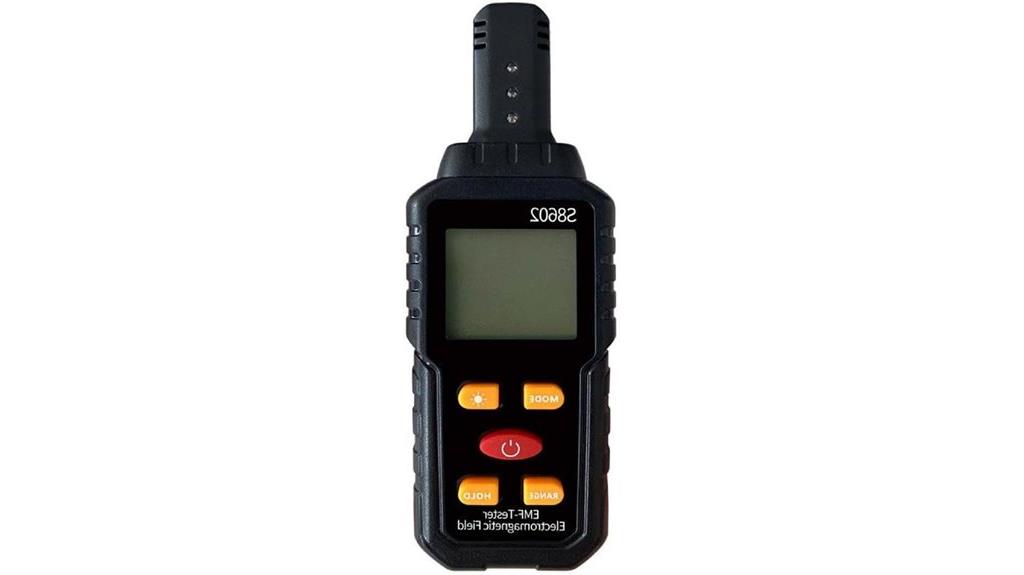
A Geiger counter nuclear radiation detector stands out as an essential tool for professionals and enthusiasts who need quick, on-the-spot evaluations of radioactive environments. However, this device primarily functions as an electromagnetic field (EMF) meter, capable of detecting electric and magnetic fields, as well as temperature. It features an alarm system that alerts users when measurements exceed safe thresholds, and a clear LCD display shows radiation trends. While marketed as a nuclear radiation detector, many users find it doesn’t measure nuclear radiation directly. Instead, it’s better suited for detecting electromagnetic interference and measuring electromagnetic safety in various environments.
Best For: hobbyists, home users, and professionals seeking to measure electromagnetic fields and assess electromagnetic safety in various environments.
Pros:
- Easy to operate with a clear LCD display and user-friendly interface
- Portable and lightweight, suitable for quick field measurements
- Alerts users with sound and visual signals when thresholds are exceeded
Cons:
- Primarily functions as an EMF meter, not a true Geiger counter for nuclear radiation
- Marketing claims may exaggerate its capabilities, leading to potential misunderstandings
- Limited to detecting electromagnetic fields; does not directly measure radioactive radiation
Eisco Labs High Quality, Standard Spectrometer – Model PH0619

For educators and students seeking precise, hands-on experience with light spectra, the Eisco Labs High-Quality Spectrometer Model PH0619 stands out as an excellent choice. Its 0-360° rotation with 1° graduations and a 0.1° vernier scale guarantee accurate measurements. The sturdy castings and heavy bearings provide durability and smooth operation. The instrument includes adjustable optical components like a collimator with a slit, achromatic lens, and a telescope with fine adjustment capabilities. With accessories like a prism table and diffraction grating holder, it offers versatility for spectroscopy experiments. This spectrometer is ideal for classroom demonstrations, student projects, and exploring optical phenomena with precision.
Best For: educators, students, and hobbyists seeking a durable, precise spectrometer for classroom experiments and optical spectroscopy projects.
Pros:
- Highly accurate with 0-360° rotation and 0.1° vernier scale for precise measurements
- Heavy castings and bearings ensure durability and smooth operation
- Versatile with adjustable optical components and accessories for varied experiments
Cons:
- Requires a separately sold prism for spectral analysis
- Relatively heavy (10.9 pounds), which may affect portability
- May be complex for very beginner users without proper guidance
Mini Spectrometer 350-800nm PPFD PAR Sensor for Engineering Lab
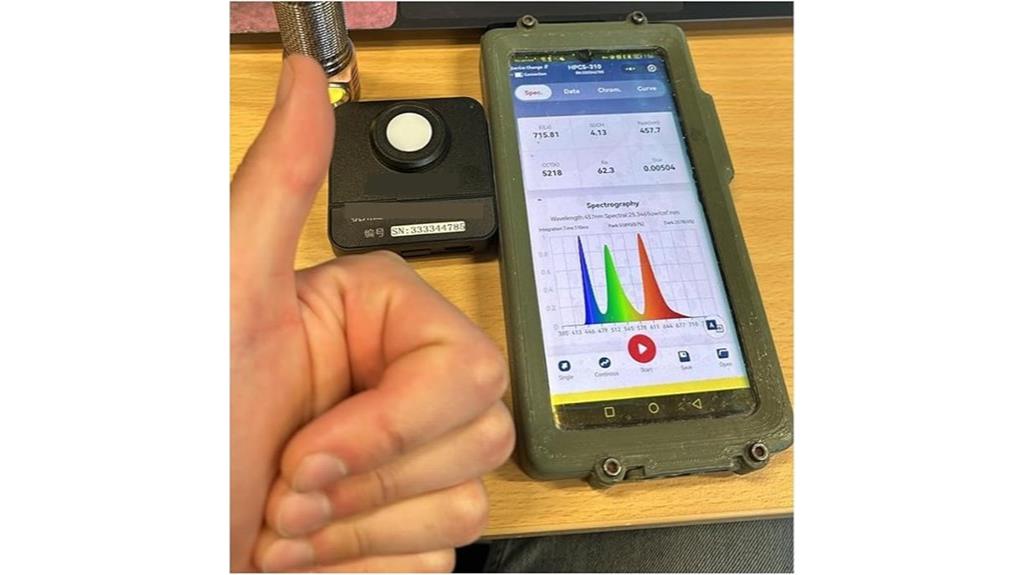
If you’re working in an engineering lab or out in the field, the Mini Spectrometer 350-800nm PPFD PAR Sensor stands out because of its ultra-portability and quick measurement capabilities. Its wide 350-800nm detection range allows for precise PPFD and PAR level readings, ideal for evaluating plant growth and LED performance. The all-in-one flicker detection feature enhances safety by identifying harmful flickering light. Compact and pocket-sized, it’s perfect for on-the-go testing in greenhouses, labs, or lighting setups. With instant readings and a user-friendly interface, it streamlines measurements, making it an essential tool for horticulture professionals, engineers, and researchers alike.
Best For: horticulture professionals, engineers, and researchers needing quick, accurate light spectrum analysis and flicker detection in the field or lab.
Pros:
- Wide 350-800nm detection range for comprehensive spectrum analysis
- Ultra-portable, pocket-sized design for easy field use
- All-in-one flicker detection enhances safety and eye comfort
Cons:
- Limited to the 350-800nm spectrum, not suitable for UV or IR measurements
- May require calibration for optimal accuracy over time
- Battery life could be limited with extended use in the field
FNIRSI GC-01 Geiger Counter Radiation Detector Personal Dosimeter
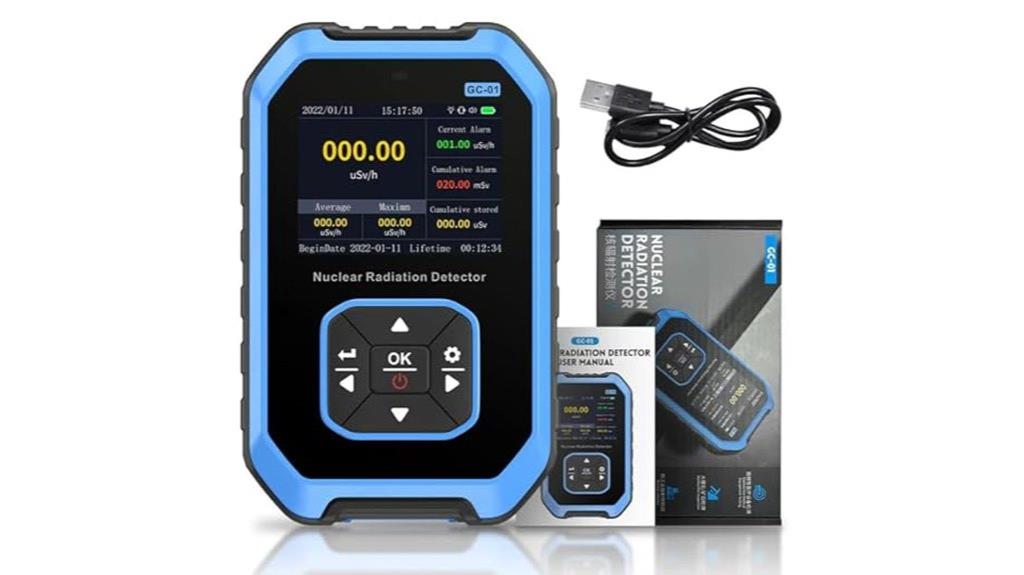
The FNIRSI GC-01 Geiger Counter Radiation Detector Personal Dosimeter stands out for anyone needing a portable and reliable tool to monitor nuclear radiation levels in real-time. Its high-precision Geiger-Müller tube detects beta particles, gamma rays, and X-rays accurately, making it perfect for safety checks and environmental testing. The device’s blue marble casing is durable and easy to handle, while its ability to set alarms and measurement thresholds provides immediate alerts. Whether you’re evaluating radioactive sources or contaminated areas, this dosimeter offers quick, precise readings. Its compact design ensures you can carry it everywhere, giving you peace of mind in radiation-sensitive environments.
Best For: individuals and professionals requiring portable, real-time monitoring of nuclear radiation levels for safety, environmental testing, or personal dosimetry.
Pros:
- High-precision Geiger-Müller tube for accurate detection of beta, gamma, and X-ray radiation
- Compact and durable blue marble casing for easy portability and handling
- Customizable alarm thresholds and measurement rates for immediate alerts and real-time monitoring
Cons:
- Limited detection range may not cover very high radiation levels
- Requires regular calibration to maintain measurement accuracy
- May not include advanced data logging or connectivity features
Digital Color Spectrometer with Φ4mm Flat Aperture, 400-700nm Wavelength Range, CMOS Dual Beam Sensor
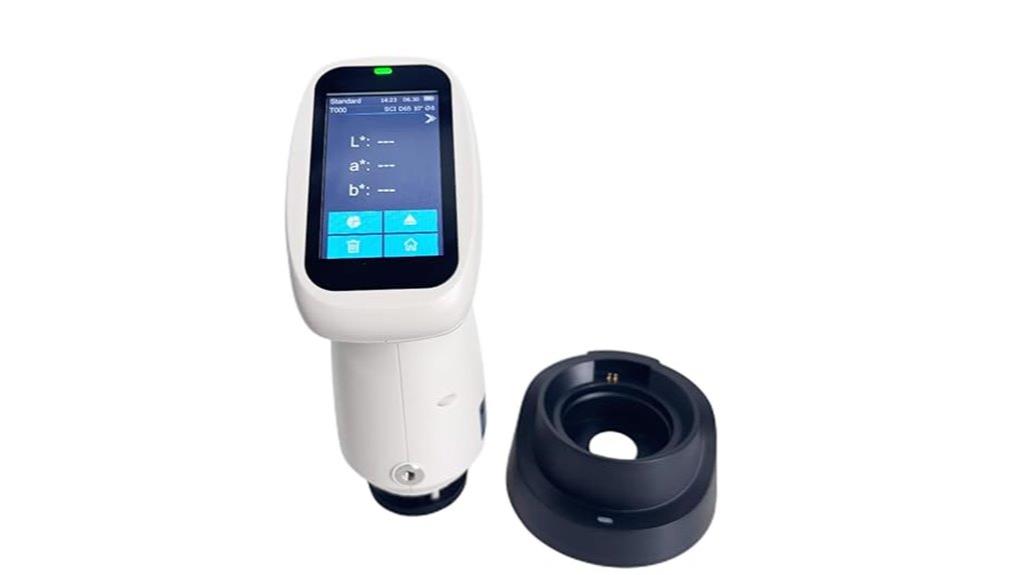
A standout feature of the Digital Color Spectrometer with Φ4mm Flat Aperture and CMOS Dual Beam Sensor is its precise measurement capabilities within the 400-700nm wavelength range, making it ideal for professionals who require accurate color analysis and quality control. Its compact, round design enhances user comfort and aesthetics. With a measurement aperture of Φ4mm, it offers high accuracy (0.01) and excellent repeatability, capturing reflectance from 0-200%. The device supports multiple color spaces and calculates various color differences, ensuring versatile application. Data storage for up to 500 samples (expandable to 10,000 via PC) makes it a reliable tool for industrial quality assurance and monitoring.
Best For: professionals in industrial quality control and color analysis seeking accurate, stable, and versatile color measurement tools.
Pros:
- High measurement precision with 0.01 accuracy and repeatability
- Supports multiple color spaces and comprehensive color difference calculations
- Compact, ergonomic design with extensive data storage capacity
Cons:
- Limited wavelength range of 400-700nm may not cover all specialized applications
- Requires PC connection for expanded data storage beyond 500 samples
- May be less suitable for non-industrial or highly mobile environments
Digital Spectrocolorimeter Color Spectrometer with Φ4mm Flat Aperture, 400-700nm Wavelength Range, CMOS Dual Beam Sensor
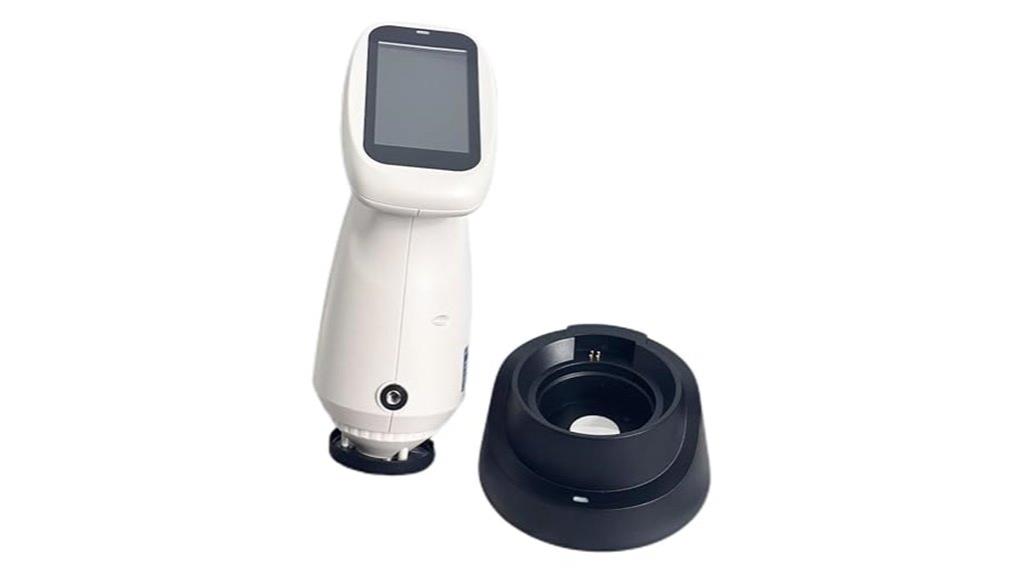
For professionals seeking precise color measurement across a broad visible spectrum, the Digital Spectrocolorimeter Color Spectrometer with Φ4mm flat aperture stands out. Its 400-700nm range and CMOS dual beam sensor deliver high accuracy, with a resolution of 0.01% and display precision. The device supports multiple color spaces like CIE LAB, XYZ, and Yxy, enabling versatile analysis. Compact and ergonomically designed, it offers easy data management, storing up to 500 samples and supporting PC integration. Its combined colorimeter and spectrocolorimeter functions guarantee reliable, stable measurements, making it ideal for industries such as printing, textiles, and coatings.
Best For: professionals in printing, textiles, coatings, and other industries requiring precise, stable color measurement across a broad visible spectrum.
Pros:
- High accuracy with 0.01% resolution and multiple supported color spaces for versatile analysis
- Compact, ergonomic design with user-friendly interface and comfortable operation
- Robust data storage capacity supporting up to 500 samples and PC integration for efficient data management
Cons:
- May require training to fully utilize advanced features and various color difference formulas
- Limited aperture size (Φ4mm) might not suit all measurement needs or larger sample sizes
- Potentially higher cost compared to basic colorimeters lacking spectrographic capabilities
Geigers Counter Nuclear Radiation Detector
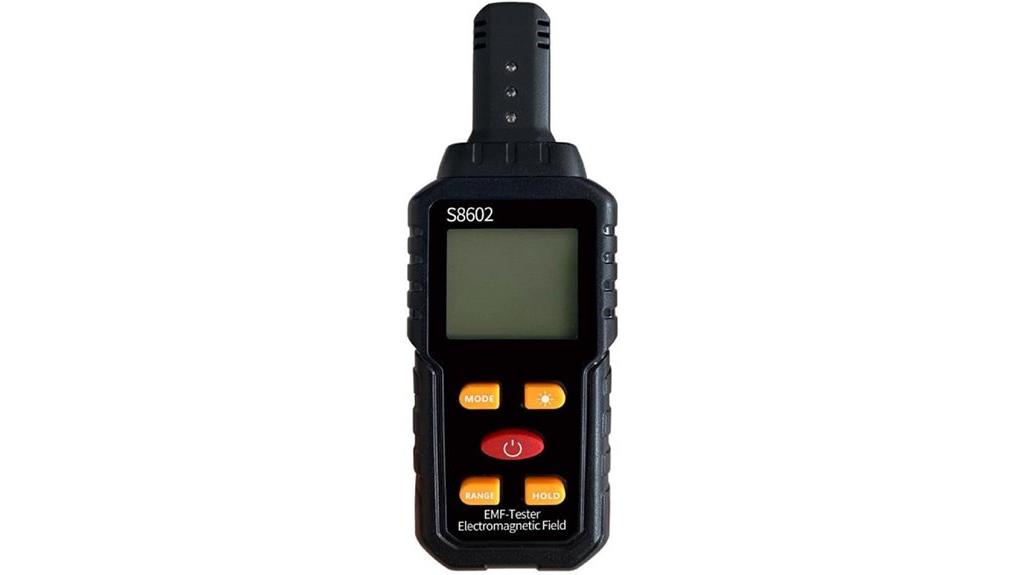
If you’re looking for a reliable way to detect radioactive and electromagnetic fields with high accuracy, the Geiger Counter Nuclear Radiation Detector is an excellent choice. It’s a versatile 3-in-1 device that measures electric fields, magnetic fields, radiation, and temperature simultaneously. Perfect for home, office, or field use, it alerts you with sounds, lights, and on-screen warnings when thresholds are exceeded—like 40V/m for electric fields or 0.4μT for magnetic fields. Its portable design, lightweight build, and easy one-handed operation make safety inspections simple, whether testing electrical equipment or environmental radiation levels.
Best For: individuals and professionals needing quick, accurate detection of radiation and electromagnetic fields in homes, offices, industrial sites, or during field inspections.
Pros:
- Combines measurement of electric fields, magnetic fields, radiation, and temperature in a single device for comprehensive testing.
- Equipped with an alarm system that provides audible, visual, and on-screen warnings for exceeded safety thresholds.
- Portable, lightweight, and designed for easy one-handed operation, making it convenient for field use and quick assessments.
Cons:
- Manual measurement errors may range from 1 to 3mm, which could affect precision in sensitive applications.
- The device’s plastic construction, while durable, may not withstand very harsh environmental conditions over long periods.
- Color variations due to monitor differences might impact visual readability or user preference.
Handheld X-Ray Spectrometer for Alloy Analysis (Truex 800)

The Truex 800 handheld X-ray spectrometer stands out as an essential tool for professionals and industries that require rapid, accurate alloy analysis on the spot. Its advanced XRF technology delivers reliable results quickly, making it ideal for quality control, sorting, and material verification. The compact, durable design ensures easy portability and dependable performance in various environments, from the factory floor to field inspections. Certified safe and eco-friendly, it meets safety standards while minimizing environmental impact. Backed by a 30-day satisfaction guarantee, the Truex 800 is trusted by many for precise, hassle-free alloy analysis whenever and wherever it’s needed.
Best For: professionals and industries needing quick, accurate alloy analysis in various environments such as quality control, sorting, and material verification.
Pros:
- Compact and portable design for easy use in the field or on-site inspections
- Fast and reliable results with advanced XRF technology
- Certified safe and eco-friendly, ensuring safety and environmental compliance
Cons:
- May require training for optimal operation and interpretation of results
- Limited to alloy analysis; not suitable for non-metallic materials
- Battery life could be a concern during extended use in remote locations
MG-2000T EMF Magnetic Gauss Meter with Case, 3-Axis Professional EMF Meter
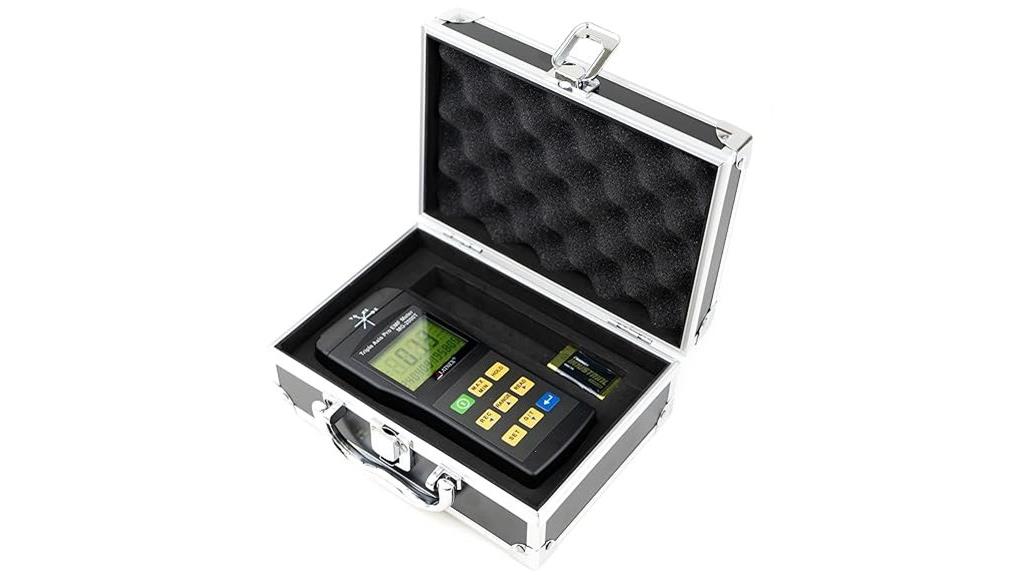
The MG-2000T EMF Magnetic Gauss Meter with Case stands out as an essential tool for professionals who need precise magnetic interference measurements in complex environments. Its three-axis sensors detect a wide range of ELF magnetic fields independently of measurement angle, ensuring accurate readings. Calibrated with a certificate, it’s reliable for testing magnetic fields around MRI machines, power lines, or industrial equipment. The device displays measurements in micro Tesla or milli Gauss, with hold, max, and min functions for thorough analysis. Compact and cost-effective, it offers quick, dependable measurements, making it ideal for electromagnetic interference assessments in medical, industrial, and residential settings.
Best For: professionals requiring precise, reliable measurements of magnetic interference in medical, industrial, and residential environments.
Pros:
- Accurate 3-axis detection for comprehensive magnetic field measurement
- Calibrated with a certification for dependable results
- User-friendly with data hold, max, and min functions for detailed analysis
Cons:
- May be more expensive than basic EMF meters for casual users
- Limited to frequencies from 30Hz to 2000Hz, not suitable for higher frequency EMF analysis
- Bulkier compared to single-axis or simpler EMF meters
Factors to Consider When Choosing Nuclear Magnetic Resonance Spectrometers

When choosing a nuclear magnetic resonance spectrometer, I focus on key factors like sensitivity, range, and sample compatibility to guarantee it meets my research needs. I also consider how easy it is to operate and analyze data, along with portability for different lab setups. These aspects help me select a device that balances performance and practicality.
Instrument Sensitivity and Range
Choosing the right NMR spectrometer depends heavily on its sensitivity and range, which directly affect its ability to detect low-concentration samples and analyze diverse nuclei. Sensitivity, measured by signal-to-noise ratio, determines how well the instrument can pick up weak signals from scarce samples. Higher frequency NMRs, with increased field strength, typically provide better sensitivity and resolution, revealing more subtle spectral details. The range of detectable magnetic field strengths influences the variety of nuclei and molecular environments the spectrometer can analyze, especially in complex samples. Additionally, the linearity and dynamic range of detectors impact the accuracy of quantitative measurements across different concentrations. Balancing sensitivity and spectral range ensures versatile, precise molecular analysis suited to specific research needs.
Sample Compatibility and Size
Selecting an NMR spectrometer requires careful consideration of sample compatibility and size to guarantee accurate and efficient analysis. You need to verify the instrument can handle your sample’s physical dimensions, including vial or container sizes. It’s important to confirm that the spectrometer’s sensitivity and resolution match your sample type, whether liquids, solids, or gases. Additionally, check if it supports the specific nuclei, like hydrogen or fluorine, present in your samples for precise measurements. Compatibility with your sample preparation methods is also vital—consider solvent compatibility and temperature requirements. Finally, assess whether the magnet’s strength and field homogeneity are sufficient to analyze your samples reliably. These factors ensure you select a spectrometer tailored to your sample’s characteristics, optimizing your results.
Ease of Operation
Ease of operation is a critical factor that can considerably impact your efficiency and confidence when using an NMR spectrometer. Simple user interfaces and clear controls make it easier to learn and reduce setup time, especially for new users. Automated calibration and self-check features help maintain accuracy without manual adjustments, saving time and minimizing errors. Intuitive software with guided workflows streamlines data acquisition and analysis, allowing you to focus on your experiments instead of troubleshooting. Well-designed physical layouts with ergonomic access to controls and displays enhance comfort during extended sessions, reducing fatigue. Additionally, thorough documentation and training resources support quick mastery of operational procedures, ensuring you can operate the spectrometer confidently and effectively from day one.
Data Analysis Features
When evaluating NMR spectrometers, it’s important to contemplate their data analysis capabilities, as these features directly influence how efficiently and accurately you can interpret your results. Advanced analysis tools, like processing complex spectra, peak assignment, and generating detailed reports, are essential. High-resolution models often include software for deconvoluting overlapping signals and quantifying multiple nuclei precisely. Compatibility with data formats such as JCAMP-DX and integration with lab information systems streamline data sharing and storage. Automated features like baseline correction, noise reduction, and spectral smoothing improve data clarity and reliability. Additionally, robust quantitative analysis functions—calculating coupling constants, relaxation times, and magnetic moments—are indispensable for comprehensive interpretation, ensuring you get the most accurate insights from your NMR experiments.
Portability and Size
Portability and size are crucial factors when choosing a nuclear magnetic resonance spectrometer, especially if you need to perform fieldwork or on-site analysis. Smaller NMR units are more portable, making them ideal for mobile applications. Compact designs reduce weight and overall size, easing transportation and setup in various environments. Portable models often integrate essential components, minimizing external accessories and simplifying operation. Size also influences power options; handheld units may run on batteries, providing greater flexibility, while larger systems typically need external power sources. Additionally, the physical dimensions affect workspace arrangement and compatibility with existing equipment. Considering these factors ensures you select a device that fits your mobility needs without compromising performance or ease of use.
Cost and Budget
Choosing the right NMR spectrometer depends heavily on your budget, as prices vary widely from around $10,000 for basic benchtop models to over $1 million for advanced research systems. Budget constraints often limit options to simpler, lower-field instruments, which have reduced sensitivity and resolution compared to high-end models. It’s essential to take into account ongoing costs, such as maintenance, software updates, and accessories, as these can considerably add to the total expense. Generally, higher-priced systems offer better magnetic stability, advanced features, and faster data acquisition, making them suitable for complex or high-precision research. However, investing in a more expensive NMR isn’t always feasible for every lab or project. Balancing your scientific needs with your budget is key to making the best choice.
Frequently Asked Questions
How Does Magnetic Field Strength Affect NMR Spectral Resolution?
Stronger magnetic fields improve NMR spectral resolution by increasing the separation between signals, making peaks sharper and easier to distinguish. When the field strength rises, the differences in resonance frequencies for various nuclei become more pronounced, reducing overlap. I’ve seen this enhance the clarity of complex spectra, especially for large molecules. So, higher magnetic fields truly help me analyze molecular structures more precisely and confidently.
What Are the Maintenance Requirements for High-Precision NMR Spectrometers?
Oh, maintenance on high-precision NMR spectrometers? It’s a breeze—if you enjoy constant vigilance! I regularly calibrate the magnets, check for helium leaks, and keep the probe clean. Dust and humidity? Not on my watch. I also schedule routine software updates and magnet shimming. Sure, it’s a bit of a dance, but keeping these marvels running smoothly is key to obtaining reliable, high-resolution spectra.
How Do Sample Sizes Influence NMR Measurement Accuracy?
Sample sizes directly impact NMR measurement accuracy. If I use too little sample, I risk weak signals, leading to noisy data and unreliable results. Conversely, overly large samples can cause magnetic field inhomogeneities, reducing resolution. Finding the right balance is essential. I always make certain my samples are within ideal volume ranges to get clear, precise spectra, which helps me analyze molecular structures with confidence.
What Safety Precautions Are Necessary When Operating NMR Equipment?
When operating NMR equipment, I always wear proper protective gear, including gloves and eye protection, to handle cryogens safely. I guarantee proper ventilation and avoid skin contact with liquid nitrogen or helium. I also follow strict procedures for sample handling and storage, and I never operate the instrument alone. Regularly checking for leaks and ensuring the equipment is properly grounded are essential safety steps I follow diligently.
How Can I Interpret Complex NMR Spectra for Molecular Structure?
When interpreting complex NMR spectra, I start by identifying the number of signals to determine the number of unique proton or carbon environments. I analyze chemical shifts, splitting patterns, and integration to deduce neighboring groups and their ratios. I also compare the spectra with known reference compounds and use software tools for simulations. This systematic approach helps me piece together the molecular structure accurately.
Conclusion
Choosing the right nuclear magnetic resonance spectrometer can open incredible insights into molecular structures. But with so many options, how will you find the perfect fit? The future of your research depends on this decision, and every choice could lead to groundbreaking discoveries or missed opportunities. Are you ready to take that next step? Trust your instincts—your most exciting scientific breakthrough might be just a decision away.
